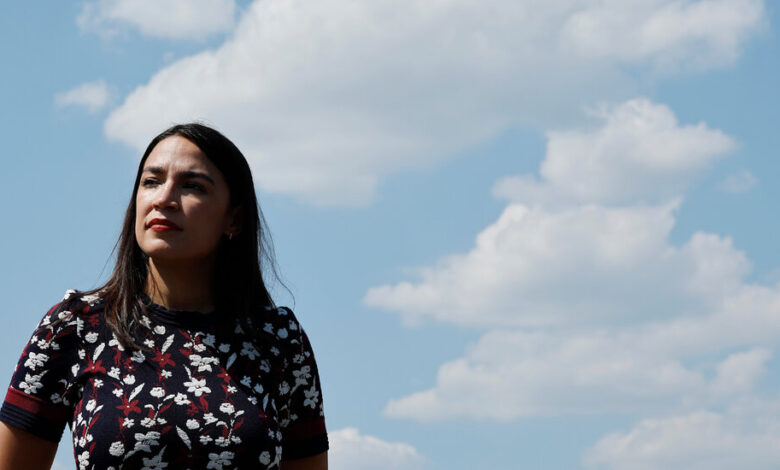Opinion | The Alexandria Ocasio-Cortez You Don’t Know

Six days after winning election to Congress, Alexandria Ocasio-Cortez did what so many young progressives do while visiting the nation’s capital: She went to a rally. It was 2018, and Democratic dissatisfaction with President Donald Trump was a constant in Washington — but Ms. Ocasio-Cortez wasn’t protesting a Republican policy. She was at a sit-in at Representative Nancy Pelosi’s office organized by a group dedicated to pushing Democrats to the left on climate issues. Ms. Pelosi said she welcomed the protest, but behind closed doors, top Democrats soon became exasperated with their new colleague.
First impressions are hard to erase, and the obstinacy that made Ms. Ocasio-Cortez an instant national celebrity remains at the heart of her detractors’ most enduring critique: that she is a performer, out for herself, with a reach that exceeds her grasp.
But Democrats frustrated by her theatrics may be missing a more compelling picture. In straddling the line between outsider and insider, Ms. Ocasio-Cortez is trying to achieve the one thing that might just shore up her fractured party: building a new Democratic coalition that can consistently draw a majority of American support.
The strategy she has come to embrace isn’t what anyone would ve expected when she arrived in Washington. In some ways, she’s asking the obvious questions: What’s broadly popular among a vast majority of Americans, and how can I make it happen? To achieve progress on these issues, she has sought common ground in places where her peers are not thinking to look. Her willingness to forge unlikely alliances, in surprisingly productive places, has opened a path to new voters — for her party, her ideas and her own political ambitions if she ever decides to run for higher office.
Since 2016, there have been two competing visions for the Democratic Party. One is the promise that began with Barack Obama of a multiracial coalition that would grow stronger as America’s demographics shifted; the other is the political revolution championed by Bernie Sanders as a way to unite nonvoters with the working class. Ms. Ocasio-Cortez bridges the gap between the two. The dream for Democrats is that one day, she or someone like her could emerge from the backbench to bring new voters into the party, forging a coalition that can win election after election. It’s too early to tell whether she has what it takes to pull that off. But what’s clear is that at a time when Democrats are struggling, she is quietly laying the groundwork to build a coalition broader than the one she came to power with, unafraid to take risks along the way.
Those instincts are in short supply in Washington. After five years in Congress, she has emerged as a tested navigator of its byzantine systems, wielding her celebrity to further her political aims in a way few others have. Three terms in, one gets the sense that we’re witnessing a skilled tactician exiting her political adolescence and coming into her own as a veteran operator out to reform America’s most dysfunctional political body.
To grasp what sets Ms. Ocasio-Cortez apart from many of her colleagues, you have to understand where she finds allies. In 2019, she and Senator Ted Cruz of Texas considered joining forces to write a bill that would bar former members of Congress from becoming lobbyists. Asked why she would consider an alliance with someone so loathed by liberals, she said, “I will swallow all of my distaste in this situation because we have found a common interest.” It was a window into the politician she would become: pragmatic and results-driven, willing to work with people she considers her political adversaries, at least on legislation that appeals to her base.
That effort with Mr. Cruz sputtered out, but she has continued to strike up working relationships with Republicans such as Dan Crenshaw of Texas, a former Navy SEAL who has supported the construction of a border wall as well as efforts to roll back abortion rights. Last year, she cosponsored a bill he’d introduced to study psychedelic drug therapy as a potential treatment for active service members with PTSD and traumatic brain injuries. She had first introduced an amendment to encourage psychedelic drug research in 2019, six months into her first term; it failed by a 331-to-91 vote. “It was on the House floor, and a member of my own party, a senior member, walked up to me and said, ‘Oh, is this your little shrooms bill?’” Ms. Ocasio-Cortez, who declined to be interviewed for this article, told The Washington Post last year. Four years later, Ms. Ocasio-Cortez and Mr. Crenshaw were able to drum up bipartisan support to pass the measure.
She has attributed the success of these efforts at least in part to her role as the second most powerful Democrat on the House Oversight Committee, which she said has “opened many windows” for collaboration. “They’re very few and far between,” Ms. Ocasio-Cortez told The Times last year, “but where we identify them, I think it’s important to burrow in.”
It was at an Oversight Committee hearing that she and other members, including Mark Meadows of North Carolina and Jim Jordan of Ohio, grilled the defense contractor TransDigm on a report that found that the company had wildly overcharged the Pentagon for its services. After the hearing, TransDigm agreed to return $16.1 million. One week later, Mr. Meadows — a member of the far-right Freedom Caucus — supported bipartisan efforts to rein in facial recognition technology, saying the initiative “hit the sweet spot that brings progressives and conservatives together.”
Ms. Ocasio-Cortez is not alone in this — other members of the informal alliance of roughly a half-dozen left-wing representatives known as the Squad have also worked with conservatives — but none have achieved her level of visibility. And while these bills may seem like small victories, they are more than that because, in a sense, she is redefining what bipartisanship looks like in Washington.
For decades, bipartisanship has meant bringing together moderates, lobbyists and establishment insiders to produce watered-down legislation unpalatable to many voters in both political parties. What Ms. Ocasio-Cortez is doing is different; she’s uniting politicians on the fringes of American politics around a broadly popular set of policies.
Americans in both parties overwhelmingly say that they don’t trust the government to do the right thing and that donors and lobbyists have too much sway over the legislative process. A Pew Research Center poll conducted last year found that more than 8 in 10 Americans believe politicians “are more focused on fighting each other than on solving problems.” One-fifth of respondents said lack of bipartisan cooperation was the biggest problem with the political system.
Seen in that light, Ms. Ocasio-Cortez’s efforts to reach out to Republicans are offering what a sizable portion of Americans want from Congress: a return to getting things done.
The few policy matters on which progressives and conservatives align often boil down to a distrust of politicians and of big corporations, particularly technology companies and pharmaceutical giants. Ms. Ocasio-Cortez has shrewdly made those causes her passion, building alliances with conservative colleagues interested in holding these industries accountable.
Last spring, she cosponsored a bill with, among others, Brian Fitzpatrick, a moderate Republican from Pennsylvania, and Matt Gaetz, the Florida rabble-rouser who has become one of Mr. Trump’s most steadfast allies. The legislation would bar members of Congress from trading individual stocks, a measure that as of the fall of 2022 was supported by nearly 70 percent of voters across party lines.
On Gaza, too, she has been willing to buck other members of her party to pursue an agenda that a majority of voters support. She was one of the first Democrats to call for a cease-fire; within weeks, nearly 70 percent of Americans said Israel should call one and try to negotiate with Hamas.
As the war has ground on and the death toll has mounted, it has tested her relationship with the far left. In March, Ms. Ocasio-Cortez was accosted by a handful of protesters who demanded that she call Israel’s war in Gaza a genocide. She had already been supportive of the Michigan activists encouraging voters to vote “uncommitted” rather than back the president in their state’s Democratic primary and had been working to persuade Democrats to support a cease-fire. But at the time, she had not yet said that Israel’s actions in Gaza amounted to genocide. The protesters wanted more.
Less than three weeks later, Ms. Ocasio-Cortez did accuse Israel of genocide and chastised the White House for providing military aid to the country while it blockaded Gaza. “If you want to know what an unfolding genocide looks like,” Ms. Ocasio-Cortez said in a speech on the House floor, “open your eyes. It looks like the forced famine of 1.1 million innocents. It looks like thousands of children eating grass as their bodies consume themselves, while trucks of food are slowed and halted just miles away.” Last month, she voted against providing additional funding for Israel. Those were unpopular positions in Congress, where unconditional support for the country remains the norm, but they put her in line with a majority of Democratic voters.
These stances haven’t been enough to quell the doubts from a faction of the left that helped get her elected. Over the past few weeks, some have accused her of caving in to pressure from moderate Democrats on Gaza, noting that she was the only founding member of the Squad to sign a statement saying that while she and the other signees opposed “supplying more offensive weapons that could result in more killings of civilians in Rafah and elsewhere,” they supported “strengthening the Iron Dome and other defense systems.”
This pattern is, at this point, familiar to close followers of the Squad, whose members are routinely criticized from the left. Ms. Ocasio-Cortez has taken much of the heat from leftist activists who see her as a symbol of the contradictions and compromises inherent in the political system. It may not be realistic to expect absolute purity from her; she is, after all, a politician. But these critiques overlook the promise of what she’s doing behind the scenes.
With six months left before Election Day, Democratic pollsters and strategists are searching for ways for Mr. Biden to win back Muslims and Arab Americans in swing states such as Michigan and Georgia, recent college graduates who hoped to have their student debt forgiven, immigrant-rights activists and Latinos. Some of the betrayal these voters feel was hardly the president’s fault; he was hampered on student loan debt by a federal judiciary stacked with judges sympathetic to conservative legal arguments, and Congress refused to pass the comprehensive immigration bill he supported in 2021, which would have provided legal status to as many as 11 million undocumented immigrants. Still, Mr. Biden has struggled to help voters understand the reasons for these failures.
A more gifted orator might have been able to make the structural impediments in his way clear to voters, while also putting forth a proactive vision for dismantling the core problems baked into our politics.
In that, someone like Ms. Ocasio-Cortez, who endorsed Mr. Biden for re-election in 2023, may be able to help. She’s the Democratic Party’s most charismatic politician since Barack Obama and its most ardent populist since Bernie Sanders. Crucially, she can offer voters something more substantial than a hollow rebuke of Trumpism. Last month, when the journalist Mehdi Hasan asked her how she’d respond to “a young progressive or Arab American who says to you, ‘I just can’t vote for Biden again after what he’s enabled in Gaza,’” Ms. Ocasio-Cortez said a vote for Mr. Biden didn’t necessarily mean an endorsement of all his policies. “Even in places of stark disagreement, I would rather be organizing under the conditions of Biden as an opponent on an issue than Trump,” she said. It was a shrewd political maneuver, designed to distance herself from Democrats who support Israel unconditionally, while meeting voters — some of whom have lost family members in Gaza — where they are. She was, in effect, acknowledging their pain and attempting to channel their righteous anger into a political movement.
There are, of course, limits to this strategy. Some on the left see Ms. Ocasio-Cortez’s endorsement of Mr. Biden as a betrayal of progressive values, particularly in the wake of the climbing death toll in Gaza. The moderate Republicans who turned out for Mr. Biden in 2020 might shrink from a Democratic Party led by someone they consider an outspoken progressive. But for every moderate or leftist voter lost with a strategy like Ms. Ocasio-Cortez’s, the Democratic Party may be able to win someone new — from the pool of disillusioned Americans who feel shut out of the political process.
The Democrats have a chance here to expand their base — and build a coalition less reliant on the whims of a shrinking group of moderates. Analyses of election data suggest that many of the Democratic voters who have defected to the other side identify as conservatives, particularly on social issues. What’s more, the once-strong Democratic support among Arab Americans, Latinos and Asian Americans now seems shaky, and Republicans have captured a large majority of white voters without college degrees. In other words, the coalition Democratic leaders could once rely on to defeat Mr. Trump is already falling apart, and their current strategy — to hammer the former president — may not be enough to win in November.
If she ever runs for higher office, Ms. Ocasio-Cortez might be able to galvanize voters of color who, despite leaning left, do not regularly show up at the polls. She could contrast her commitment to issues that matter to a large number of voters, like raising the minimum wage and protecting reproductive rights, with Republicans’ endless culture wars. And she could frame herself as one of the few Democrats who opposed unconditionally spending billions on an unpopular war while Americans struggled to afford groceries and gas.
She could take the message that catapulted her into Congress — as a tireless champion of the underclass — to the national level. In some ways, she already has. Ms. Ocasio-Cortez hit the picket line with striking United Auto Workers members in Missouri and requested a hearing on the train derailment in East Palestine, Ohio, nearly a year before Mr. Biden visited the community. These are constituencies the Democratic Party has been losing, perhaps because they’ve written them off as Republican voters, if they bother to vote at all. But in the same way Ms. Ocasio-Cortez isn’t afraid to collaborate with conservatives when it helps her policy agenda, she has shown up for people whom other Democrats have abandoned — and voters may remember that when they cast a ballot in 2028.
Gaby Del Valle is a reporter based in Brooklyn whose work has appeared in The Intercept, Politico, The Nation and other publications.
The Times is committed to publishing a diversity of letters to the editor. We’d like to hear what you think about this or any of our articles. Here are some tips. And here’s our email: [email protected].
Follow the New York Times Opinion section on Facebook, Instagram, TikTok, X and Threads.




